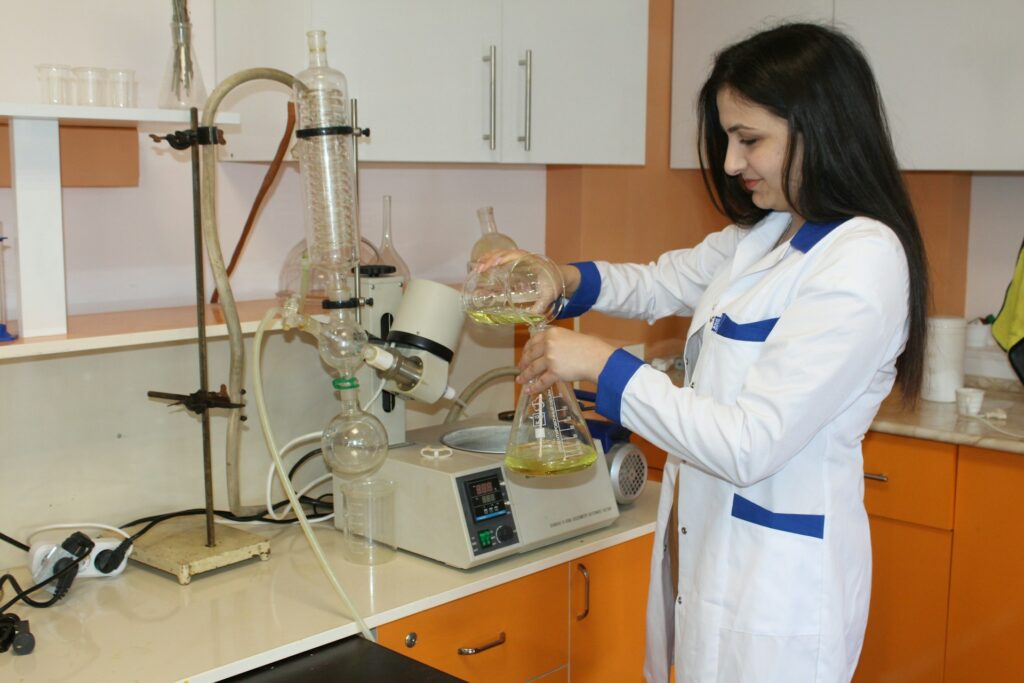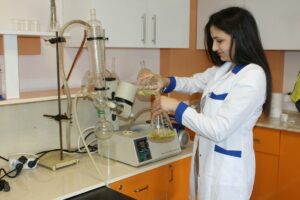The Importance of Artificial Intelligence in the Process of Finding New Materials and Medicines

The Importance of Artificial Intelligence in the Process of Finding New Materials and Medicines
Over the course of several decades, the development of novel materials and treatments has been mostly dependent on human intuition, experimentation through trial and error, and years of testing in their own laboratories. Despite the fact that this method has resulted in great advancements, it is also somewhat slow, expensive, and constrained by the cognitive capabilities of humans. This approach is currently being revolutionized by artificial intelligence (AI), which is allowing scientists to investigate chemical and molecular possibilities that go well beyond the capabilities of old methodologies. AI is helping to usher in a new age of discovery by modeling, predicting, and optimizing at a speed that has never been seen before. This new age of discovery will be characterized by progress in materials and medicine that is measured in weeks rather than decades.
How Artificial Intelligence Quickens the Discovery Process
Pattern recognition is the backbone of artificial intelligence (AI). It has the ability to examine enormous databases of chemical structures, reactions, and biological interactions in order to discover underlying links that may go unnoticed by humans. When it comes to material science, artificial intelligence has the ability to forecast how various combinations of components will behave under specified conditions. On the other hand, when it comes to medicines, it can foresee how molecules will interact with particular biological targets. Through the utilization of this skill, researchers are able to skip over numerous phases of experimental guessing and get directly to the candidates that show the most promise.
The evolution of research from being driven by data to being driven by intelligence
Historically, research has relied on the gathering of data, which involves collecting and analyzing outcomes to determine what is effective. Through the use of machine learning models that are able to not only analyze data but also produce hypotheses, artificial intelligence goes beyond this. Algorithms that use deep learning simulate millions of different possible configurations and then filter those configurations through multiple layers of reasoning in order to formulate novel medicine molecules or materials that have desirable qualities. This change represents a move from research that is driven by data to discovery that is driven by intelligence, in which machines actively contribute ideas and insights rather than just processing information.
Artificial Intelligence in the Process of Drug Discovery and Design
at the field of pharmaceuticals, artificial intelligence is causing a revolution at almost every stage of the drug discovery pipeline. When it comes to identifying proteins that cause disease and creating compounds that are able to properly connect with those proteins, artificial intelligence helps reduce both time and uncertainty. The use of generative models allows for the production of new molecular structures that satisfy particular criteria for bioavailability, stability, and safety. Researchers are able to forecast how a substance could react in the human body with the use of predictive algorithms, which may reduce the need for extensive testing on animals or early-stage testing on humans.
The creation of “virtual molecules” by the application of deep generative models is a prime example of this methodology. Prior to their synthesis in the laboratory, these digital compounds are subjected to a computer screening process to identify desirable characteristics. The ability of artificial intelligence to recognize novel therapeutic targets and even generate viable drug candidates in a fraction of the typical amount of time required for drug development has been demonstrated by companies such as DeepMind and Insilico Medicine.
Implementing Machine Learning to Quicken the Pace of Material Science
In the field of materials science, artificial intelligence is being applied to the same concepts that drive drug development. Artificial intelligence is being used by researchers to build materials that are healthier, lighter, and more sustainable for a variety of applications, including aerospace components and batteries. A new compound’s behavior can be predicted using machine learning models, which can simulate atomic interactions and forecast how the compound would behave under different pressures, temperatures, or electrical circumstances.
A particularly significant capability of artificial intelligence is its capacity to map the link between structure and function. For instance, artificial intelligence can examine millions of different chemical combinations in order to determine which candidates have the greatest potential for larger capacity or faster charge cycles. This is done in the context of the quest for better materials for energy storage. This not only helps to reduce waste and the influence that it has on the environment, but it also helps to speed up innovation.
The Strength Enabled by Predictive Modeling
Discovery that is powered by artificial intelligence is built on predictive modeling. Scientists may now conduct “in silico” simulations, which are virtual experiments that test theories computationally, as an alternative to depending entirely on physical tests. The way in which molecules fold, the way in which materials conduct heat or electricity, and the way in which medications will interact with human cells may all be predicted using these models. As a consequence, the cycle of hypothesis, validation, and refinement is completed at a considerably faster pace.
During the COVID-19 pandemic, artificial intelligence systems offered assistance in the identification of potential antiviral drugs and assisted in the design of vaccines by examining the protein structures of the virus. This predictive power became particularly apparent during this pandemic. With the help of artificial intelligence-assisted modeling, what used to take years of structural biology research was now completed in just a few weeks.
Going from Unpredictability to Accuracy
Not only can artificial intelligence contribute to the pace of discovery, but it also brings precision. In traditional experimental methods, there is frequently a degree of randomness involved, and the exploration of chemical space is accomplished by extensive testing. However, artificial intelligence intelligently narrows that search. It acquires knowledge from each and every failure and success, continually honing its comprehension of the factors that contribute to the effectiveness or stability of a chemical. This iterative development is a reflection of the fundamental scientific process, but it operates at the speed and scale of digital technology.
Interactions Between Humans and Machines Working Together
Although artificial intelligence (AI) is responsible for providing computing capacity, human scientists continue to be indispensable for evaluating data, determining the course of research, and enforcing ethical standards. Collaboration is the most effective method for achieving breakthroughs. In this scenario, artificial intelligence is responsible for handling massive-scale calculation and pattern identification, while humans add creativity, judgment, and contextual knowledge. Researchers are transformed into “AI-augmented scientists” as a result of this relationship, which enables them to investigate hitherto inaccessible areas of chemistry and biology.
Ethical and Practical Obstacles to Deal With
There will be difficulties involved in the process of incorporating AI into the discovery of materials and drugs. The quality of the data continues to be a major concern; erroneous forecasts might be the result of datasets that are biased or incomplete. When an artificial intelligence creates a molecule, there are additional problems regarding ownership and intellectual property. Who is the proprietor of the molecule? To add insult to injury, regulatory systems have not yet fully adapted to AI-driven drug development, which involves the partial automation of many traditional testing and validation activities. It is of equal importance that artificial intelligence models be both transparent and interpretable, particularly in the field of health, where judgments might have life-or-death repercussions.
Success Stories from the Real World
Several high-profile triumphs are examples of the transformational potential of artificial intelligence. AlphaFold, a program developed by DeepMind, made a significant advancement in the field of biology in the year 2020 by successfully predicting the structures of proteins. Since then, this significant development has sped up the process of drug discovery across the business. In the field of materials science, artificial intelligence has being utilized by businesses to create novel catalysts for more environmentally friendly chemical processes and to locate polymers of the future generation that are both long-lasting and recyclable. A much larger revolution is just getting started, and these accomplishments are just the beginning.
A Glance Into the Future Ahead of Us
We may anticipate the arrival of AI-driven laboratories in the not too distant future. These laboratories will be autonomous research environments in which robotic systems will conduct experiments led by AI algorithms. These labs will do thousands of tests on a daily basis, continuously improving the quality of the material and medication candidates they are working with. Artificial intelligence will be able to improve its forecast accuracy even more with the incorporation of quantum computing, which will enable scientists to mimic chemical interactions with atomic precision.
At the end of the day, intelligence serves as the catalyst for discovery.
In a short amount of time, artificial intelligence is quickly becoming the driving force behind the subsequent wave of scientific discoveries. The process of discovering new materials and therapies is being revolutionized by artificial intelligence (AI), which combines human ingenuity with computational intelligence. In addition to a more rapid discovery process, the end result is innovation that is better informed, more sustainable, and more exact. The continued development of this technology holds the possibility of a future in which achievements that were previously thought to be unattainable will become routine. In this future, scientific progress will not be made at the rate of experimentation, but rather at the speed of intelligence itself.




